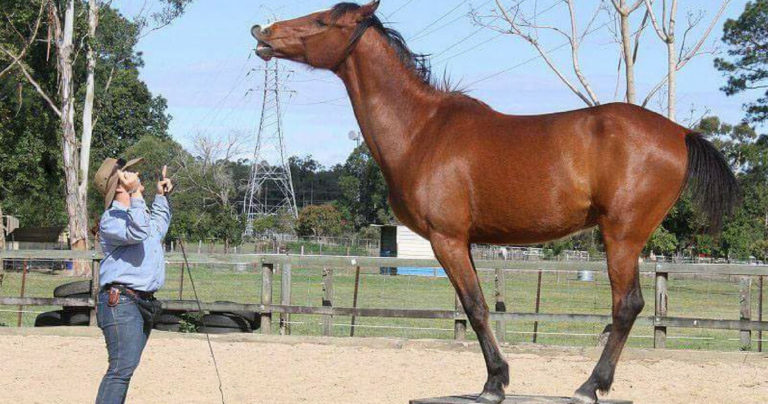
Clicker training refers to the method of teaching a behaviour using a “yes” signal or conditioned reinforcer. This tells the horse precisely when it has done something right. The “click” in clicker training refers to a small plastic noisemaker that makes a distinctive sound upon pressing the metal part into the plastic case. Immediately after pressing the clicker, a food reward is offered to the horse as a positive reinforcer to encourage the horse to continue displaying that particular behaviour.
Clicker Training has a long history in marine parks where dolphins and whales needed to learn specific behaviours to perform for the public, however how do you harness or ‘halter’ a dolphin?! Hence a positive and rewarding method evolved in order to reinforce the animals to jump, dive and show off with the result being a fish or food treat so as the animal would want to repeat the desired behaviour. Trainers would blow a whistle as soon as the animal had either shown a natural behaviour ie; jumping out of the water, and then immediately after the whistle was blown, the dolphin would be thrown a fish. To shape a desired behaviour, such as swimming through a hoop – trainers would leave a hoop in the water, and when the dolphins would swim towards the hoop, the whistle was blown and the dolphin would receive a fish. Very quickly the dolphin’s learnt to keep repeating behaviours or evolve a behaviour further in order to receive their reward!
So why should we clicker train our horses?
Clicker Training or Positive Reinforcement training is widely used in the majority of animal training industries. Wildlife centres, Zoos and centres for exotic animals, dog trainers, and movie animal trainers generally use and promote the use of positive reinforcement training because it is not only scientifically proven to create exceptional results, it also takes into consideration a very high level of animal welfare. Unfortunately, the horse industry has been one of the last industries to slowly embrace this excellent and rewarding training approach despite the clear evidence of its success.
When used with the regular ‘negative reinforcement’ method ie; pressure/release horsemanship principles or comfort/discomfort techniques, Clicker Training can give the horse TWO reasons why they should continue to display and demonstrate the required behaviour. (1) They get a release from physical pressure ie; leg pressure to walk sideways; and (2) a click and immediate food reward. Suddenly just moving away from pressure because it’s uncomfortable becomes really WANTING to move away from pressure because the horse LIKES to step sideways! Why does he like it? He gets a treat! Clicker training is also exceptional for teaching unusual behaviour such as trick training, or for horses that need a bit more confidence in certain situations. Horses that spook easily take to clicker training very well, and suddenly that scary umbrella, is now the umbrella they can’t wait to stand under as it means a food reward.
The Challenges
So you think your horse is too pushy and food motivated? You think this will make him more bossy and naughty? WRONG! Like any training technique, performed and taught correctly, you will get just the opposite. Teach your horse to back away from you and wait patiently for his reward, rather than treating you as the vending machine to push over and bully his way for a carrot, you can create a calm and willing horse that knows his owner takes the food to him, rather than him reaching forward to his owner to snatch the carrot. If this process is consistent and the rules always remain the same, your horse will forever know that calm and patient behaviour results in his carrot, yet pushiness results in either correction to walk backwards (using negative reinforcement) or simply nothing at all.
What can I use it for?
The most common use for clicker training in the horse industry thus far is for less natural behaviours such as targeting (touching) objects, picking things up in their mouth such as your hat or saddlecloth, performing a bow, lay down, smile or ‘trick’ behaviour, and sometimes also for liberty training. However clicker training works to encourage ANY behaviour you want your horse to repeat happily and confidently without excessive force. Yes you could wiggle your lead rope harder, or pull on your horse mouth with more strength, or perhaps get bigger spurs, but I can guarantee you, if you introduce clicker training you won’t need to go to these lengths, and your horse will most certainly like you a lot more for it and be a lot happier and more willing to repeat the behaviour you are looking for. Movements such as jumping, flying changes, passage, piaffe, sliding stops, spins, roll backs and a simple halt are performed with enthusiasm and fast quality results when your horse understands there is something more in it for him, rather than just ‘I don’t like the pressure so I’ll get away from it because it’s unenjoyable’. Suddenly he will be asking to do an amazing sliding stop because he knows he is rewarded with a rest AND a treat!
Not convinced? Go along to a clinic with a trainer who endorses positive reinforcement or clicker training alongside regular good horsemanship methods, and go along with an open mind. Watch the trainer’s horses and you will see they not only get great results, but their horses are happier, more willing, and more creative than most horses that are only trained using negative reinforcement. The proof really is in the pudding.
______
Hayley Chambers-Holt is an experienced and accomplished animal trainer running her own successful business – Animal Instincts Australia. Along with John Downes, she also manages Outback Equines, a unique horse training business offering clinics, demonstrations and displays in horsemanship, trick horse training, horse archery, clicker training and more.
Photo credit to Katy Driver






